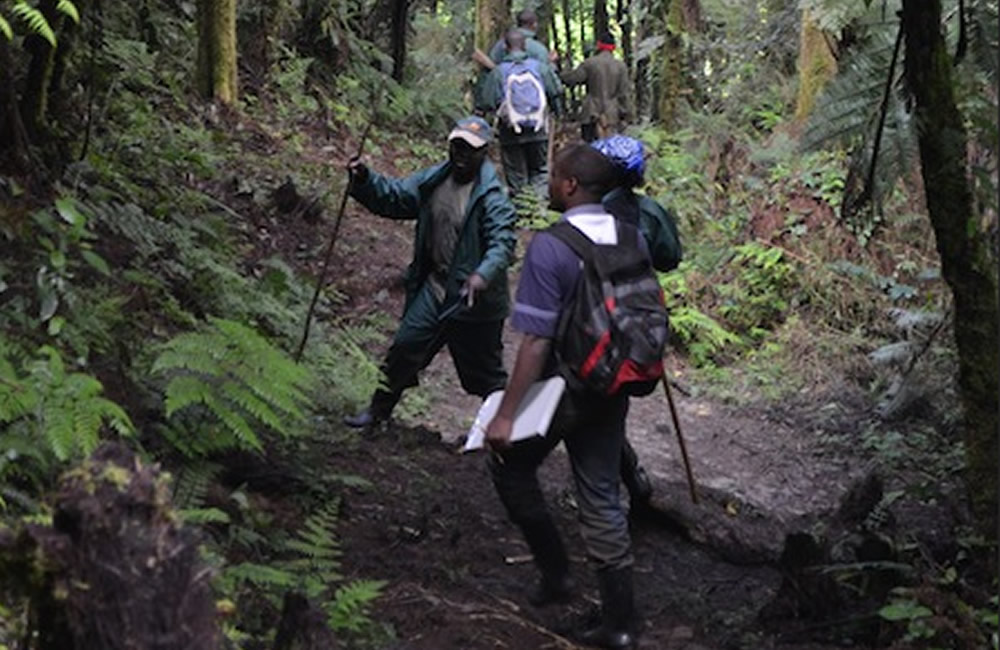Mountain gorillas live in only three countries: DR Congo, Rwanda, and Uganda. In 2010, a census took place in Rwandan and DR Congo National Parks along the Virunga Massif. In 2011, the results were announced at 480 mountain gorillas. When combined with the 300 mountain gorillas from Uganda’s 2006 census, the world total came to 780. Last year, a new census took place in Uganda’s Bwindi Impenetrable Forest, and the results were released today. Here is a report from the International Gorilla Conservation Programme (IGCP). Photos by Anna Behm Masozera – IGCP:
Kampala, Uganda: A census of mountain gorillas, Gorilla beringei beringei, conducted in 2011 in Bwindi Impenetrable National Park, Uganda, confirms a minimum population of 400 gorillas, raising the world population of mountain gorillas to 880. The official result was released today by the Uganda Wildlife Authority.
The increase in the Bwindi population since the last census, from 302 in 2006 to 400 in 2011, is attributed to improved census techniques of these rare and elusive apes as well as real population growth.
In this latest census, teams systematically moved through Bwindi not once, but twice, looking for and documenting mountain gorilla night nests and feces, and collecting fecal samples for genetic analysis. The first sweep was conducted with a small team from February 28 to September 2, 2011 and the second sweep conducted with multiple teams from September 10 to November 3, 2011. With the genetic analysis, scientists were able to determine how many unique groups and individuals were found by the field census teams through both sweeps.
In short, the two sweeps of Bwindi allowed census teams to find more gorillas than a single sweep would have. Further, it is likely that some gorillas were missed by field census teams in the 2006 census of Bwindi’s mountain gorillas. But all signs are that this population of mountain gorillas is indeed growing.
“This method gives us the clearest picture of the status of mountain gorillas in Bwindi that we have yet had,” states Maryke Gray, Technical Advisor to the International Gorilla Conservation Programme (IGCP).”Even with evolving census methods, the results indicate that this population has indeed increased over the last five years, and that is very encouraging for this critically endangered species.”
Mountain gorillas live in social groups and the census results indicate that the 400 mountain gorillas in Bwindi Impenetrable National Park form 36 distinct social groups and 16 solitary males. Ten of these social groups are habituated to human presence for either tourism or research and included, at the time of the census, 168 mountain gorillas or 42% of the Bwindi population.
While it was initially planned to include ICCN’s Sarambwe Nature Reserve in the Democratic Republic of Congo, a protected area continuous with Bwindi and therefore potential habitat for mountain gorillas, it was not possible due to insecurity in the Sarambwe area at the time of the census.
The total world population of mountain gorillas now stands at a minimum of 880, representing the 400 individuals in Bwindi confirmed in this 2011 census and 480 mountain gorillas in the Virunga Massif confirmed by a census in 2010. Both populations of mountain gorillas have had positive trends in population growth over the last decade.
“In fact, the mountain gorilla is the only great ape whose population is increasing despite continuous pressure on its habitat. This positive trend is due to the strong collaboration among the three countries where mountain gorillas live and the collective efforts on the ground by park staff, surrounding communities and local government, and non-governmental organizations,” adds Dr. Augustin Basabose, Interim Director of IGCP.
The 2011 Bwindi mountain gorilla census was conducted by the Uganda Wildlife Authority with support from l’Institut Congolais pour la Conservation de la Nature and the Rwanda Development Board. The census was also supported by the International Gorilla Conservation Programme (a coalition of the African Wildlife Foundation, Fauna & Flora International, and WWF), the Max Planck Institute for Evolutionary Anthropology, Conservation Through Public Health, the Mountain Gorilla Veterinary Project, the Institute of Tropical Forest Conservation, and the Dian Fossey Gorilla Fund International.
This census was funded by WWF-Sweden with supplemental support from Berggorilla & Regenwald Direkthilfe e.V., the Wildlife Conservation Society, and the Max Planck Institute for Evolutionary Anthropology.
